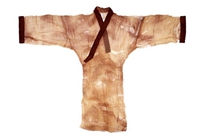In Hunan, there is a famous mysterious old granny, who came from the ancient China over 2,000 years ago. This “thousand-year-old” granny’s story has attracted people from all around the world …
在湖南,有一位老奶奶人尽皆知,她来自2000多年前的古代中国,身世传奇,我们都叫她“千年老娭毑”,她的神秘故事吸引了无数中外游客……
She is Lady Xin Zhui— the wife of Changsha Chancellor Li Cang. Native Changshanese all affectionately call her Xin Zhui “ai jie”.
她,就是长沙国丞相利苍的妻子——辛追夫人,长沙人都亲切地称她为“辛追娭毑”。
The excavation of Xin Zhui was really legendary. In the 1970s, when No. 366 Hospital stationed near Mawangdui was building underground wards and warehouses, combustible gas was accidentally found, which was an evidence of the existence of the Mawangdui Han Dynasty Tombs. From 1972 to 1974, Hunan Museum excavated the Mawangdui Han Dynasty Tombs, and unearthed more than 3,000 precious cultural relics and a well-preserved ancient cadaver.
辛追夫人的发掘可谓充满传奇。20世纪70年代,驻扎在马王堆附近的366医院在修建地下病房和仓库时意外地发现了可燃气体,触动了马王堆汉墓。自此,在1972年至1974年间,湖南省博物馆对马王堆汉墓进行了抢救性发掘,出土了3000多件珍贵文物和一具保存完好的古尸。
Xiaogao: Wow, this must be Xin Zhui “ai jie”! I really wonder what she looks like.
小高:哇,这就是辛追娭毑对吧!真好奇她到底长什么样子。
The body of Xin Zhui was 1.54 meters long and weighed 34.3 kilograms. When she was unearthed, she was wrapped in 20 layers of silk clothes. Because the body was too old with no protective measures, and the wrapped clothes were too thick, it took about a week to peel off all the layers. The archaeologists had scarce hope for the preservation of Xin Zhui’s remains, but they did not expect that the remains would be so well preserved — her whole body was moisturized and complete, and her joints could still move. Her subcutaneous connective tissue was still elastic, as if she had just passed away. When the antiseptic was injected, her soft tissues like the skin, flfl esh and blood vessels bulged as the medicine flowed, and then diffused through the capillaries. Even in her esophagus and stomach, there were still a few melon seeds that she ate before she died.
辛追夫人的遗体身长1.54米,体重34.3公斤。她出土时,全身裹着20层丝绸衣服,由于年代太过久远,也没什么保护措施,加上包裹着的衣物太厚,所以经过一周左右才剥离完毕。本来考古人员对辛追遗体的保存完整度并没抱什么希望,但没想到,遗体竟然保存得如此完好——全身润泽,外形完整,关节仍然可以活动,尸体的皮下结缔组织还有弹性,就像刚刚去世不久的样子。在注射防腐剂时,皮、肉、血管等软组织,随着药水所到而鼓起,然后通过微血管扩散。甚至,在她的食道和胃里还保存着一些死前吃下的甜瓜子!
This peculiar phenomenon was really awe-inspiring. What a miracle in the history of anti-corrosion in the world! Having aroused great reaction in the international academic circles, this Oriental Sleeping Beauty more than 2,000 years ago has also become the top treasure of the Hunan Museum. If you want to admire the remains of Xin Zhui and learn more about her stories and life experience, Hunan Museum will be your best choice.
这一奇特现象,令人大感惊叹,堪称世界防腐史上的奇迹,在国际学术界引起巨大反响,这位2000多年前的“东方睡美人”也成了湖南省博物馆的镇馆之宝。如果想亲自瞻仰辛追夫人的遗容,了解更多她生平的故事和身世,不妨来湖南省博物馆一探究竟!
Xiaoliu: But I can’t wait! Please tell me more about her stories!
小刘:可是我等不及啦!快先告诉我一点儿关于她的故事吧!
After the experts dissected the body, the mystery of Xin Zhui’s death was revealed: she suffered from a variety of diseases during her lifetime, and biliary colic caused coronary heart disease, which seemed to be the cause of her sudden death. The 138 undigested melon seeds found by the researchers in her esophagus and intestines also seemed to indicate that Xin Zhui died of an emergency after eating a large amount of melons.
专家们对遗体进行解剖之后,解开了辛追夫人的死亡之谜:她生前患有多种疾病,胆绞痛引起冠心病发作,似乎是导致猝死的原因。而研究人员在她的食管、肠胃内发现的138粒未消化的甜瓜子似乎也说明,辛追夫人是在食用过大量甜瓜后突发急症而亡。
More than 3,000 precious cultural relics were unearthed along with Xin Zhui. They show the life and art of Changsha in the early Han Dynasty, including food, clothing, housing, artistic creation, health and fifi tness maintenance, and the pursuit of immortality.
随辛追夫人一起出土的,还有3000多件珍贵文物。它们展示了汉初长沙国的生活和艺术,涵盖衣食住行、艺术创造、养生健体以及古人追求永恒的愿景。
Xiaowen: How did the archaeologists find out her identity when she was unearthed? How did they know that she was the wife of Changsha Chancellor?
小文:辛追夫人刚出土的时候,考古学家是怎么知道她到底是谁的,又怎么知道她是长沙国丞相的夫人的呢?
Before the official excavation, the mysterious identity of the owner of the Mawangdui Han Dynasty Tombs was an unsolvable mystery, and the code to unlock the mystery of Xin Zhui’s life experience was the following evidences — three small seals.
在正式发掘之前,马王堆墓主人的神秘身份是一个不解之谜,而解开辛追夫人身世之谜的密码,就是下面这三件“证物”——三枚小小的印章。
Jade Seal of “Li Cang”
Three little seals were unearthed from Tomb 2. Jade Seal of “Li Cang”, one of them, with Chinese character “ 利苍 ” (the name of Changsha Chancellor) carved on the seal in seal script, told the identity of the occupant—the first Marquis Dai, Changsha Chancellor.
“利苍”玉印
2号墓出土了三枚印章,“利苍”玉印便是其中之一,印上刻有篆书“利苍”二字,证明了2号墓主人应该是第一代轪侯、长沙国丞相利苍。
Bronze Seal of “Changsha Chancellor”
Bronze Seal of “Changsha Chancellor” proved that Li Cang was the Chancellor of Changsha State, which was given by the imperial government.
“长沙丞相”铜印
这枚“长沙丞相”铜印是证明2号墓墓主利苍身份的三枚印章之一。印面雕刻有篆书“长沙丞相”,可见是墓主利苍的官印。
Bronze Seal of “Marquis Dai”
This is a symbol of Li Cang’s nobility as the Marquis Dai.
“轪侯之印”铜印
这枚铜印是证明2号墓墓主利苍身份的三枚印章之一,是墓主利苍的爵位印。
Xiaowang: I’ve heard that there were many hot girls in Han Dynasty. Lady Xin Zhui must also be a beautiful granny!
小王:听说汉代有好多美女,辛追夫人应该也是一个漂亮的老太太吧?
Researchers restored the looks of Xin Zhui at all ages. She was quite an aristocratic lady with dignified and generous manners. In the Hunan Museum, you can see the beauty of Lady Xin Zhui when she was alive through restoring her image.
研究人员复原了辛追夫人生前各个年龄段的长相,她的仪态端庄大方,颇有贵族风范。在湖南省博物馆,你就能看到复原的辛追夫人真容!
What kind of garment should match the nobility of Lady Xin Zhui? What you should never miss is this legendary Plain Unlined Gauze Gown below. “Light as fog and thin as the wings of cicada” might be the most accurate description of this Plain Unlined Gauze Gown. It was woven by extra thin silk with plain color, with a total length of 128 cm and 190 cm from sleeve to sleeve, but a total weight of only 49 grams.
能配得上辛追夫人这样的“贵妇”的衣服是什么样的呢?不得不提的就是下面这件素纱襌衣——“轻若烟雾,薄如蝉翼”用来形容这件素纱襌衣应该是最恰当不过的了。素纱指的是没有染色的纱,襌衣指的是没有衬里的衣服。这件襌衣是用极细的素色蚕丝织成的薄纱裁剪缝制而成,整件衣服衣长128厘米,通袖长190厘米,而重量却只有49克。
What did ancient Chinese people wear such a thin and light gown for? Some believe it was used as an outfit for its beautiful design, which was in line with the Chinese aesthetic value of being implicit, while some believe it was underwear.
如此轻薄飘逸的衣服,古人穿着是干嘛的?多数学者认为它可能穿在外面,既可增添华丽,又可产生朦胧美感。这倒是正好符合了中国人含蓄、内敛的传统审美情趣。但也有学者认为它是当作一种内衣穿着的。
It can be said that this is the oldest, thinnest and the most intact ancient clothing with the most refifi ned technique.
可以说,这是迄今世界上现存年代最早、保存最完整、制作工艺最精,也是最轻薄的一件衣服。

Xiaoyang: It is said that people in the Han Dynasty often researched on the “secret recipe” for immortality. So mysterious ...
小杨:据说汉代人常研制长生不老的秘方,追求永生,真是太神秘了……
Well, we don’t know whether there are secret recipes for immortality in Xin Zhui’s tomb , but the “T-shaped silk painting” from Xin Zhui’s tomb conveys some ancient views on the universe and life to us.
辛追夫人的墓中有没有长生不老的“秘方”,我们暂且不知,但墓中出土的“T形帛画”向后人传递了些许古人的宇宙观和生命观。
T-shaped silk paintings are “non-clothes”, commonly known as “spiritual banners”, which mark the identity and name of the tomb occupant. During the funeral, people used a bamboo pole to lift it up high and held it at the front of the funeral procession. During the funeral, it was covered on the inner coffin as a medium for the tomb occupant’s soul ascending to heaven.
“T形帛画”即“非衣”,俗称“招魂幡”,标示着墓主人的身份、名氏。出殡时,人们用一根竹竿将它高高地挑起,举在送葬队伍的最前面,入葬时将它覆盖在内棺上,作为墓主灵魂升天的媒介。
This T-shaped silk painting is 205 cm in length, 92 cm in width at the top, and 47.7 cm in width at the bottom. It is composed of three single layers of fifi ne brown silk, and from top to bottom it depicts the images of the heaven, the world, and the underground.
这幅T形帛画通长205厘米,顶宽92厘米,末端宽47.7厘米,由三块单层棕色细绢拼成,自上而下描绘天上、人间、地下的图像。
On the top of the silk painting, ancient people’s imagination of heaven is drawn: between the sun and the moon sits a heavenly god with human head and snake body, surrounded by his long, red tail. Underneath him there is the gate to the heaven guarded by doorkeepers and dragons, fairy birds and monsters with strange looks. On the top right corner draws a round, red sun with a dark fairy bird at the center, and the Fusang Tree (a giant mulberry tree in Chinese legend) with eight suns hanging on its branches at the bottom. On the top left corner arises a crescent moon, on which sit the fabled toad and the Jade Hare, and Chang’e, the goddess in the moon, is flfl ying underneath to the moon.
帛画上方描绘了古人对于天堂的想象:日月之间,端坐着一个人首蛇身的天帝,一条红色的长尾环绕于周围。在他的下方,有一道天门,有守卫的门吏,另有神龙、神鸟和异兽相衬。右上角,有一轮红日,日中有一只黑色的神鸟,红日下方的扶桑树间有八个太阳。左上角有一弯新月,月亮上有蟾蜍和玉兔,月下画着奔月的嫦娥。
In the middle section of the painting is the mortal world. The mortal world is divided into two parts by a giant jade. The upper part depicts the scene of the tomb occupant ascending to the heaven, while the lower part shows the sacrifice for the tomb occupant. Under the canopy and the winged bird, there is a profifi le portrait of an elderly noblewoman. She seems to be walking slowly with a stick with two petty offifi cials kneeling in front and three attendants standing in the back, surrounded by two giant dragons.
中段画人间世界。人间由玉璧一分为二,上层画的是墓主人的升天,下层画的是对墓主人的祭祀。神鸟之下,是一位年老妇人的侧面像。她似在拄杖缓行,前有两位小吏迎接,后有三位侍从随行,四周还有两条神龙环绕。
Xiaogao: Perhaps this noblewoman is Lady Xin Zhui?
小高:或许,这位贵妇人就是辛追夫人?
The lower part of the silk painting is an underground scene, perhaps the ancients’ imagination of hell. In the painting, a naked giant holds a wooden board symbolizing the earth. He stands on two intertwined whales, surrounded by turtles and owls, with a snake crawling through his legs.
帛画的下段是地下景象,或许是古人对地狱的想象。画中,一个裸体巨人双手擎托着象征大地的木板,他站在两条交错的鲸鲵上面,胯下有蛇穿过,四周还有大龟、猫头鹰等。
In fact, the mysterious story of Xin Zhui is only one of the many historical secrets in Hunan, and the cultural relics unearthed from the Mawangdui Han Dynasty Tombs are only one of the many exhibits in Hunan Museum. Today’s Hunan Museum is the largest museum of history and art in Hunan Province, which covers an area of 49,000 square meters and has a total area of 91,000 square meters.In addition to the cultural relics unearthed from the Mawangdui Han Dynasty Tombs, there are more than 180,000 cultural relics in the collection. It features Shang and Zhou bronze wares, Chu cultural relics, ceramics of the past dynasties, calligraphy works and paintings, and modern cultural relics.Here, you will see Liling porcelain which represents the peak of oriental ceramic art, spiritual bronze animals, glorious lacquerware, mysterious Miao culture, and the delicate Hunan embroidery art, etc. Here, countless stories and secrets about Hunan culture are all waiting for you to reveal.
其实,辛追夫人和她的神秘故事还只是湖南众多历史秘密中的一个,马王堆汉墓出土文物还只是湖南省博物馆众多陈列中的一项。如今的省博,是湖南省最大的历史艺术类博物馆,占地面积4.9万平方米,总建筑面积为9.1万平方米,除了马王堆汉墓出土 文物,现有馆藏文物18万余件,其中尤以商周青铜器、楚文物、历代陶瓷、书画和近现代文物为特色。代表东方陶瓷艺术高峰的醴陵瓷、灵性的青铜动物、光彩熠熠的漆器、神秘的苗族文化、针尖上的湘绣艺术……关于湖湘文化数不尽的故事和秘密,都在这里等待你来一探究竟。



 湘公网安备:43010302000524号
湘公网安备:43010302000524号

 继续访问
继续访问